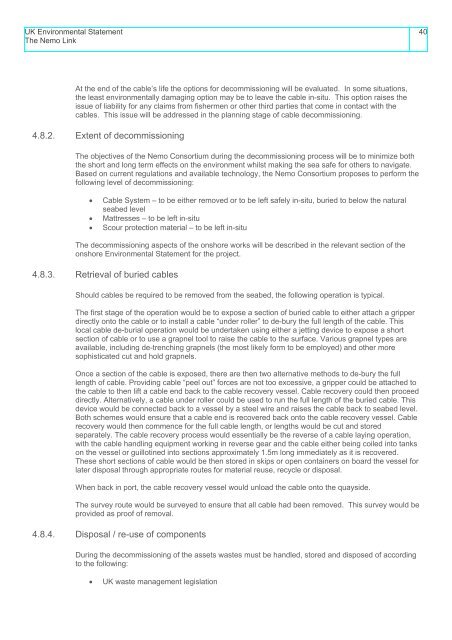Nemo-Link-UK-Marine-Environmental-Statement
Nemo-Link-UK-Marine-Environmental-Statement
Nemo-Link-UK-Marine-Environmental-Statement
Create successful ePaper yourself
Turn your PDF publications into a flip-book with our unique Google optimized e-Paper software.
<strong>UK</strong> <strong>Environmental</strong> <strong>Statement</strong>The <strong>Nemo</strong> <strong>Link</strong>40At the end of the cable’s life the options for decommissioning will be evaluated. In some situations,the least environmentally damaging option may be to leave the cable in-situ. This option raises theissue of liability for any claims from fishermen or other third parties that come in contact with thecables. This issue will be addressed in the planning stage of cable decommissioning.4.8.2. Extent of decommissioningThe objectives of the <strong>Nemo</strong> Consortium during the decommissioning process will be to minimize boththe short and long term effects on the environment whilst making the sea safe for others to navigate.Based on current regulations and available technology, the <strong>Nemo</strong> Consortium proposes to perform thefollowing level of decommissioning:Cable System – to be either removed or to be left safely in-situ, buried to below the naturalseabed levelMattresses – to be left in-situScour protection material – to be left in-situThe decommissioning aspects of the onshore works will be described in the relevant section of theonshore <strong>Environmental</strong> <strong>Statement</strong> for the project.4.8.3. Retrieval of buried cablesShould cables be required to be removed from the seabed, the following operation is typical.The first stage of the operation would be to expose a section of buried cable to either attach a gripperdirectly onto the cable or to install a cable “under roller” to de-bury the full length of the cable. Thislocal cable de-burial operation would be undertaken using either a jetting device to expose a shortsection of cable or to use a grapnel tool to raise the cable to the surface. Various grapnel types areavailable, including de-trenching grapnels (the most likely form to be employed) and other moresophisticated cut and hold grapnels.Once a section of the cable is exposed, there are then two alternative methods to de-bury the fulllength of cable. Providing cable “peel out” forces are not too excessive, a gripper could be attached tothe cable to then lift a cable end back to the cable recovery vessel. Cable recovery could then proceeddirectly. Alternatively, a cable under roller could be used to run the full length of the buried cable. Thisdevice would be connected back to a vessel by a steel wire and raises the cable back to seabed level.Both schemes would ensure that a cable end is recovered back onto the cable recovery vessel. Cablerecovery would then commence for the full cable length, or lengths would be cut and storedseparately. The cable recovery process would essentially be the reverse of a cable laying operation,with the cable handling equipment working in reverse gear and the cable either being coiled into tankson the vessel or guillotined into sections approximately 1.5m long immediately as it is recovered.These short sections of cable would be then stored in skips or open containers on board the vessel forlater disposal through appropriate routes for material reuse, recycle or disposal.When back in port, the cable recovery vessel would unload the cable onto the quayside.The survey route would be surveyed to ensure that all cable had been removed. This survey would beprovided as proof of removal.4.8.4. Disposal / re-use of componentsDuring the decommissioning of the assets wastes must be handled, stored and disposed of accordingto the following:<strong>UK</strong> waste management legislation


